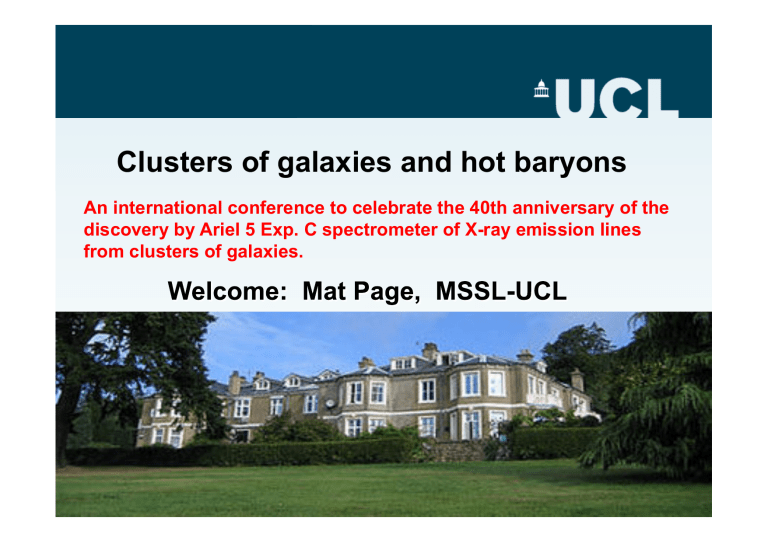Clusters of galaxies and hot baryons

Clusters of galaxies and hot baryons
An international conference to celebrate the 40th anniversary of the discovery by Ariel 5 Exp. C spectrometer of X-ray emission lines from clusters of galaxies.
The beginning of MSSL: UCL‘s Rocket Group
Sir Harrie Massey (1908 – 1983) was the true founder of space research in the UK. He created the ‘Rocket Group’ in UCL Physics Department in 1953 and was offered the opportunity to use sounding rockets (some left over from
WWII) for upper atmosphere research.
Kiruna, Sweden 1970
Woomera, South Australia 1965
Sardinia, Italy 1967
The Mullard Space Science Laboratory
(MSSL)
• In 1965 Mullard Ltd made a donation to UCL to establish MSSL.
Holmbury St Mary site was purchased, renovated and formally opened
in 1967. MSSL’s first director was Sir Robert Boyd (1922 – 2004)
• More than 270 rockets and satellites have gone into space carrying
hardware developed at MSSL
• MSSL hardware is currently
operating in space in 14 instruments
on 12 spacecraft
• Long history of international
collaborations
MSSL and comet Hale-Bopp 1997
Current operating projects Cluster II
• Hinode – EIS
• Hinode – FPP
• SOHO
• Cluster II
• Mars Express
• Venus Express
• INTEGRAL
• Swift
• XMM-Newton OM
• XMM-Newton RGS
• Gaia
Gaia
XMM-Newton
Future projects
• ASTROSAT
• ExoMars
• James Webb Space Telescope
• SMILE
‘ESA Cosmic Vision’:
• Solar Orbiter
• Euclid
• JUICE
• PLATO
• ATHENA
ExoMars
Solar Orbiter
JWST
Now to the conference that begins today.
• It’s 40 years since X-ray emission lines were discovered in clusters of galaxies with Ariel 5. It meant that clusters contained huge reservoirs of hot gas.
• Looking back, that was a massive discovery.
• One of the scientists (Len Culhane) who made that discovery is still working here at MSSL today.
Clusters of galaxies and hot baryons
• Seemed like a great opportunity to have a scientific meeting 40 years on
– based on the study of the hot gas in clusters
– all the astrophysics and cosmology that’s related
– in the very laboratory where the instrument was built
– and the discovery was made
– and with one of the original investigators talking
• A forward looking meeting, but with a bit of nostalgia and history mixed in
• Opportunity for a bit of a party tomorrow as well
To set the context.
• This is what the
Universe looks like in dark matter according to cosmological simulations.
• The clusters are the dense nodes in the filamentary structure of dark matter.
• They are connected to everything else.
Simulation by the VIRGO consortium
The hot gas in clusters, groups and filaments
Galaxy formation
AGN
Hot cluster gas
Cosmology
Dark matter
Welcome
• I think we have a great programme.
• I hope this will be an interesting, informative, enjoyable and friendly meeting.
• Most of the talks have been given 40 minutes, which I hope will be 30 minutes + 10 minutes questions.
• Mix of participants, from starting PhD students to world authorities.
• No question is too stupid.
• I’m looking forward to learning a lot in the next 3 days.
• Lets get started!








